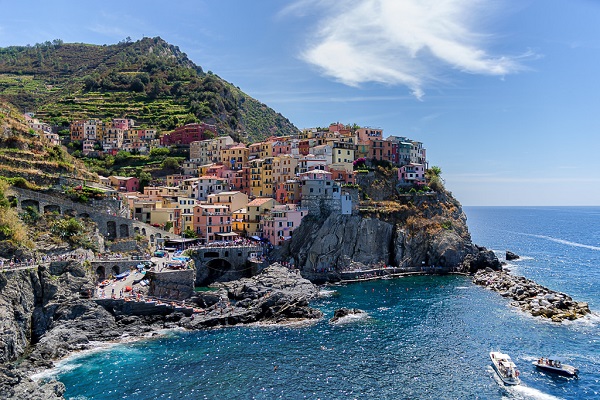CSS Masking
The CSS mask-image Property
CSS masking allows you to create a mask layer to place over an element to partially or fully hide portions of the element.
The CSS mask-image property specifies a mask
layer image.
The mask layer image can be a PNG image, an SVG image, a CSS gradient, or an SVG <mask> element.
Use a PNG Image as the Mask Layer
To use a PNG image as the mask layer, use a url() value to pass in the mask layer image.
The mask image needs to have a transparent or semi-transparent area. Black indicates fully transparent.
Here is the mask image ("w3logo.png") we will use:

Here is an image from Cinque Terre, in Italy:

Now, we apply the mask image as the mask layer for the image from Cinque Terre, Italy:

Example
Here is the source code:
.mask1 {
-webkit-mask-image: url(w3logo.png);
mask-image:
url(w3logo.png);
mask-repeat: no-repeat;
}
Try it Yourself »
The mask-image property specifies the image
to be used as a mask layer for an element.
The mask-repeat property specifies if or how
a mask image will be repeated. The no-repeat
value indicates that the mask image will not be repeated (the mask image will
only be shown once).
Repeat the Mask Layer Image
If we omit the mask-repeat property, the mask image will be repeated all over the image from Cinque Terre, Italy:

Example
Omit the mask-repeat property:
.mask1 {
-webkit-mask-image: url(w3logo.png);
mask-image:
url(w3logo.png);
}
Try it Yourself »
Position the Mask Layer Image
The
mask-position property sets the starting position of a mask image
(relative to the mask position area). By default, a mask image is placed at the
top-left corner of an element, and repeated both vertically and horizontally.
Here, we position the mask image in center:

Example
Position the mask layer image:
.mask1 {
-webkit-mask-image: url(w3logo.png);
mask-image:
url(w3logo.png);
mask-repeat: no-repeat;
mask-position:
center;
}
Try it Yourself »
CSS All Masking Properties
The following table lists all the CSS masking properties:
| Property | Description |
|---|---|
| mask-clip | Specifies which area is affected by a mask image |
| mask-composite | Specifies a compositing operation used on the current mask layer with the mask layers below it |
| mask-image | Specifies an image to be used as a mask layer for an element |
| mask-mode | Specifies whether the mask layer image is treated as a luminance mask or as an alpha mask |
| mask-origin | Specifies the origin position (the mask position area) of a mask layer image |
| mask-position | Sets the starting position of a mask layer image (relative to the mask position area) |
| mask-repeat | Specifies how the mask layer image is repeated |
| mask-size | Specifies the size of a mask layer image |
| mask-type | Specifies whether an SVG <mask> element is treated as a luminance mask or as an alpha mask |

